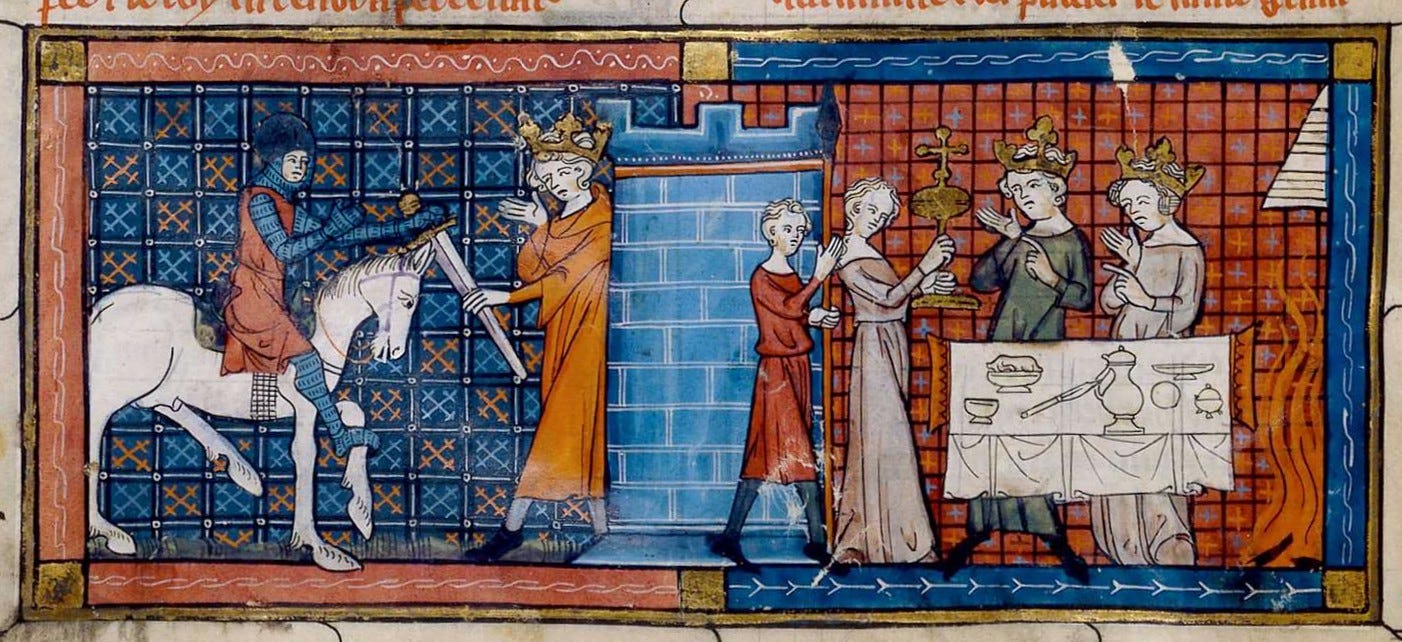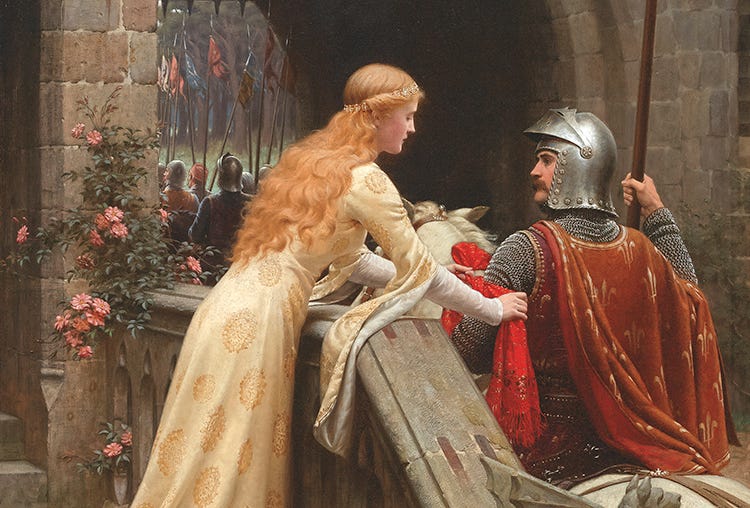Be without fear in the face of your enemies. Be brave and upright that God may love thee. Speak the truth always, even if it leads to your death. Safeguard the helpless and do no wrong. That is your oath. <Godfrey backhands Balian across the face>. And that is so you remember it.
The ethos of chivalry
Well, Kingdom of Heaven is good fun, though wildly inaccurate in many ways, but that is a fair summary of the chivalric knightly ethos, as it is usually romanticized. A knight who adheres to the tenets of chivalry should:
be brave, strong, and skillful, known at the time as showing “prowess”
respect women (more on that in a moment)
defend the weak
be loyal to his lord
be courteous and merciful to both friends and enemies
A few hundred years after Richard we can find Chaucer writing in The Canterbury Tales that a worthy knight was one who “loved chivalrie, trouthe, and honour, fredom and curteisie.”
But where did this ethos, this concept, which is still alive today, come from?
To simplify somewhat, it came from the troubadours and the patronage of Eleanor of Aquitaine. And from that, we can trace a direct line to the Arthurian traditions we know today, King Arthur and the Knights of the Round Table, and all that. And from there, direct to today’s romance novels.
Eleanor and the courts of Aquitaine
As we’ve covered before, Eleanor’s grandfather was William IX, “the first troubadour.” When her father was dying in 1137, he placed her (and the Aquitaine, to which she was heir) into the care of King Louis VI of France, then William died. Louis VI quickly engaged Eleanor to his son Louis. Louis VI promptly died as well, so in a span of a few weeks, Eleanor went from single to the Queen of France.
Eleanor had grown up in the courts of Aquitaine, and apparently loved music and poetry. The only contemporary record of her education comes from the troubadour Bertran de Born, who stated that she read the poetry of her native tongue, which would have been Occitan. But over the course of her life, she will be a patron of musicians and poets, as will her daughter Marie de Champagne. Bertran de Born, Jaufré Rudel, Bernart de Ventadorn, troubadours we have encountered in previous episodes, were all supported by Eleanor.
The early troubadour tradition of the south consisted mostly of love songs. But after her marriage, her court went north to Paris with the king, and with her she brought troubadours, minstrels, and entertainers. The culture of the north prized military valor; while the south was love songs, the north was in a state of constant military conflict, and their secular arts were centered on epic poetry: the Song of Roland, and the like.
The origins of Chivalry
At the courts in Paris and the north, the courtly love songs of the south crashed into the heritage of Charlemagne and battles of northern France, Normandy, and Anjou. The troubadour songs began to embrace the love of battle together with the praise for courtly love. The songs often depicted knights undertaking quests not just for glory but for the love of a lady, intertwining martial valor with romantic aspiration. This melding of themes enriched both literature and societal norms, as the values espoused by troubadours became woven into the fabric of knightly conduct. The troubadour's portrayal of love as a noble pursuit elevated the status of romantic relationships in the eyes of society.
It is important to say that chivalry was as much a literary concept as a real one. Chivalry is usually recorded in stories written about a past time, almost a sort of nostalgia. So we find chivalric concepts promoted in The Song of Roland, written around 1100 but about events happening around 700. Whether real knights obeyed this chivalric ideal is, let’s say, somewhat questionable. Saladin, for example, was (and is) often depicted as a chivalric, courteous leader. This did not stop him from brutally decapitating helpless hostages after the Battle of Hattin and sending thousands of Christians into slavery. I am reminded of a line from A Perfect Spy by John Le Carré, spoken by the scoundrel Rick Pym: “I say this. Ideals are like the stars. We cannot reach them, but we profit by their presence!”
Courtly love
The concept of courtly love extolled the idea that one should seek a lover not one’s spouse. A troubadour might pine for a woman of the court, perhaps even his lord’s wife, and seek her favor. Physically, if possible, emotionally, if not. Jaufré Rudel, who we encountered in part II of this series, formulated the concept of amor de lonh, “distant love,” the notion of being hopelessly in love with an unobtainable woman (and songs where the noble woman pines for the unobtainable man were also written by female troubadours). It is not hard to see this notion alive and well in the romance novels of today.
Much of this can be traced to the system of arranged marriages in European nobility of the time. Most noble children were pawns, often married off before their teenage years to cement some political alliance. But love will out, as they say, so there is no surprise that those stuck in arranged marriages might wish for a lover. The troubadour songs also inverted the social order - in a marriage, the woman was the servant to the man, whereas in troubadour songs, the male lover was utterly a slave to the desires and whims of his lady. He must prove his worth, often by completing some quest.
Buried at the heart of chivalry is thus a moral contradiction: a knight should be honorable, truthful, merciful, etc., but he is also supposed to try to sleep with his boss’s wife.

Chretien de Troyes
And that contradiction leads us to Chrétien de Troyes, sometimes known as “the first novelist.” Chrétien was a poet and writer of the northern courts, supported financially by Marie, Eleanor’s daughter. Around 1170, during Richard’s childhood, he began composing epic works that married the ideas of courtly love with the Arthurian legends and the notions of questing, and outlining “proper behavior.”
His stories, long verse poems, including Lancelot, the Knight of the Cart, Yvain, the Knight of the Lion, and others, became the core of the chivalric tradition, and are still alive today in the tropes of modern romance novels.
You can see the moral contradiction evidenced in the forbidden romance of Lancelot and Guinevere, and its disastrous consequences.
At the time these works were called romans, because they were written in vernacular languages derived from Latin. This term survives in phrases like ‘romance languages,' ‘romance novels,’ and the like. And the Arthurian tradition popularized by Chrétien led to Malory’s Le Morte D’Arthur, to T. H. White’s The Once and Future King, and continue to this day.
Some etymology
The rise of courtly chivalry produced words we use to this day.
The word chivalry derives from the French word for ‘horse’, cheval. A chevalier was thus a man (noble) with a horse, the plural of chevalier is chevalerie, which produced our word ‘chivalry’. Cavalry is from an Italian derivation of the same root word.
The Old French word cort (enclosure, yard) became the word for the court where a ruler’s people gathered, and became our word court, meaning either a place where a ruler gathered, or where disputes were adjudicated, and from that follows courtesy (‘courtly manners’), courteous (“courtly behavior”), curtsie, courtly, “courting” a woman, courtesan, and so on.
Next time
Today we’ve covered the apex of the troubadour tradition, and its flowering at the courts of Eleanor through her patronage. Next time, we’ll talk about Richard as troubadour, and the legend of Blondel, who was said to have located Richard during his imprisonment by singing a secret song outside castle walls until Richard responded. Then conclude our troubadour series with the destruction of the troubadour culture in the south during the Albigensian Crusade, and ‘The Last Troubadour.’
Let me leave you with some music:





